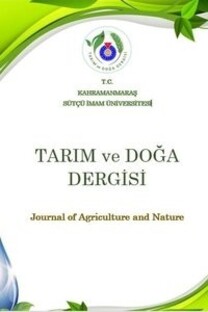Antioxidant Activity, Isolation and Identification of Some Chemical Constituents of Sphaerophysa kotschyana
Sphaerophysa kotschyana Bitkisinin Antioksidan Aktivitesi ve Bazı Kimyasal Bileşenlerinin Izolasyonu ve Belirlenmesi
___
Attaur Rahman, Choudhary MI 2001. Bioactive natural products as a potential source of new pharmacophores. A theory of memory. Section Title: General Biochemistry 73 (3): 555–560.Blanco N, Flores Y, Almanza GR 2008. Secondary Metabolites From Senna Versicolor. Revista Boliviana de Química 25 (1): 36–42.
Blois MS 1958. Antioxidant determinations by the use of a stable free radical. Nature 181: 1199–1200.
Davies KJ 1995. Oxidative stress: the paradox of aerobic life. Biochemical Society symposium 61: 1– 31.
Davies KJ 2000. Oxidative stress, antioxidant defenses, and damage removal, repair, and replacement systems. IUBMB Life 50: 279–289.
El-Domiaty MM, Aal MMA, Abou-Hashem MM, AbdAlla RH, Wink M 2009. Antihepatotoxic Activity and Chemical Constituents of Buddleja asiatica Lour. Zeitschrift fur Naturforschung - Section C Journal of Biosciences 64 (1–2): 11–19.
Elmastaş M, Gülçin I, Beydemir Ş, Küfreviolu ÖI, Aboul-Enein HY 2006. A study on the in vitro antioxidant activity of juniper (Juniperus communis L.) fruit extracts. Analytical Letters 39: 47–65.
Gülçin I 2012. Antioxidant activity of food constituents: An overview. Archives of Toxicology 86 (3): 345–391.
Gülçin I, Oktay M, Kireçci E, Küfrevioǧlu ÖI 2003. Screening of antioxidant and antimicrobial activities of anise (Pimpinella anisum L.) seed extracts. Food Chemistry 83 (1): 371–382.
Gulcin I, Tel AZ, Kirecci E 2008. Antioxidant, antimicrobial, antifungal, and antiradical activities of Cyclotrichium Niveum (BOISS.) Manden and Scheng. International Journal of Food Properties 11 (2): 450–471.
Halliwell B, Cross CE 1994. Oxygen-derived species: Their relation to human disease and environmental stress. Environmental Health Perspectives 102 (10): 5–12.
Halliwell B, Gutteridge JMC 1984. Oxygen toxicity, oxygen radicals, transition metals and disease. Biochemical Journal 219: 1–14.
Halliwell B, Gutteridge JMC 2007. Free Radicals in Biology and Medicine. Oxford University Press, New York 905–2015 .
Hamzaoğlu E, Aksoy A 2009. Phytosociological studies on the halophytic communities of central Anatolia. Ekoloji 14: 1–14.
Jiao LJ, Wang WD, Tao YD, Shao Y, Mei LJ, Liu ZG, Wang QL, Dang J 2018. 8-isopentenyl isoflavone derivatives from the whole herb of Sphaerophysa salsula. Natural Product Research 32 (21): 2542– 2546.
Li GY, Wang JH, Li X 2005. Sterols from the pericarp of Sphaerophysa salsula DC. Journal of Asian Natural Products Research 7 (2): 165–169.
Lin X, Jiajie X, Qiaoli L, Ruimei X, Gehong W 2009. Genetic diversity in rhizobia isolated from Sphaerophysa salsula in several regions of northwestern China. Biodiversity Science 17 (1): 69–75.
Ma Z, Fujii I, Ebizuka Y, Li X, Shimomaki S, Sakano Y 2004. Flavonoids from the seeds of Sphaerophysa salsula. Journal of Asian Natural Products Research 6 (1): 69–73.
Ma Z, Li X, Li N, Wang J 2002. Stilbenes from Sphaerophysa salsula. Fitoterapia 73 (4): 313–315.
Ma Z, Tian J, Fujii I, Ebizuka Y, Li X 2003. A new lignan from the seeds of Sphaerophysa salsula. Natural Product Research 17 (6): 423–425.
Misra LN, Siddiqi SA 2004. Dhaincha (Sesbania bispinosa) leaves: A good source of antidiabetic (+)- pinitol. Current Science 87 (11): 1507.
Oyaizu M 1986. Studies on products of browning reaction. Antioxidative activities of products of browning reaction prepared from glucosamine. The Japanese Journal of Nutrition and Dietetics 44 (6): 307–315.
Polhill RM 1981. Advances in legume systematics: parts 1 & 2. Kew, Royal Botanic Gardens 2: 1–7.
Popov KI, Sultanova N, Rönkkömäki H, Hannu-Kuure M, Jalonen J, Lajunen LHJ, Bugaenko IF, Tuzhilkin VI 2006. 13C NMR and electrospray ionization mass spectrometric study of sucrose aqueous solutions at high pH: NMR measurement of sucrose dissociation constant. Food Chemistry 96 (2): 248–253.
Re R, Pellegrini N, Proteggente A, Pannala A, Yang M, Rice-Evans C 1999. Antioxidant activity applying an improved ABTS radical cation decolorization assay. Free Radical Biology and Medicine 26 (9): 1231–1237.
Rengarajan T, Rajendran P, Nandakumar N, Balasubramanian MP, Nishigaki I 2014. Free radical scavenging and antioxidant activity of Dpinitol against 7, 12 dimethylbenz (a) anthracene induced breast cancer in sprague dawley rats. Asian Pacific Journal of Tropical Disease 4 (5): 384–390.
Sharma N, Verma MK, Gupta DK, Satti NK, Khajuria RK 2016. Isolation and quantification of pinitol in Argyrolobium roseum plant, by 1H-NMR. Journal of Saudi Chemical Society 20 (1): 81–87.
Singh RK, Pandey BL, Tripathi M, Pandey VB 2001. Anti-inflammatory effect of (+)-pinitol. Fitoterapia 72 (2): 168–170.
Slinkard K, Singleton V 1977. Total phenol analysis: automation and comparison with manual methods. The American Journal of Enology and Viticulture 28: 49–55.
Trouwborst A 2014. Exploring the legal status of Wolfdog hybrids and other dubious animals: International and EU law and the wildlife conservation problem of hybridization with domestic and alien species. Review of European, Comparative and International Environmental Law 23 (1): 111–124.
Venkateswarlu S, Satyanarayana B, Sureshbabu C V, Subbaraju G V 2003. Synthesis and antioxidant activity of 4-[2-(3,5-dimethoxyphenyl)ethenyl]-1, 2- benzenediol, a metabolite of Sphaerophysa salsula. Bioscience, Biotechnology and Biochemistry 67 (11): 2463–2466.
Vermerris W, Nicholson R 2006. Phenolic compounds and their effects on human health. In Phenolic Compound Biochemistry. Springer, Dordrecht 235– 255.
Yildiztugay E, Ozfidan-Konakci C, Kucukoduk M 2013. Sphaerophysa kotschyana, an endemic species from Central Anatolia: Antioxidant system responses under salt stress. Journal of Plant Research 126 (5): 729–742.
- ISSN: 2619-9149
- Yayın Aralığı: Yılda 6 Sayı
- Başlangıç: 2018
Bilal KESKİN, Hakkı AKDENİZ, Mehmet Ali BOZKURT
Dianthus L.’ta (Caryophyllaceae) Bazı İsimlerin Lektotipifikasyonu
The Factors Affecting Food Security in the Eastern Region of Afghanistan
Asıf Khan AHMADZAI, Cuma AKBAY
Kerim Mesut ÇİMRİN, Huda Nur ÇAKIR
Effect of Farmyard Manure on Mineral Nutrition of Rye (Secale cerale L.) Plant
Aydın ADİLOĞLU, KORKMAZ BELLİTÜRK, Sevinç ADİLOĞLU, Yusuf SOLMAZ
Afganistan'ın Doğu Bölgesinde Gıda Güvenliğini Etkileyen Faktörler
Cuma AKBAY, Asıf Khan AHMADZAI
Abdussamat GÜZEL, MAHFUZ ELMASTAŞ
